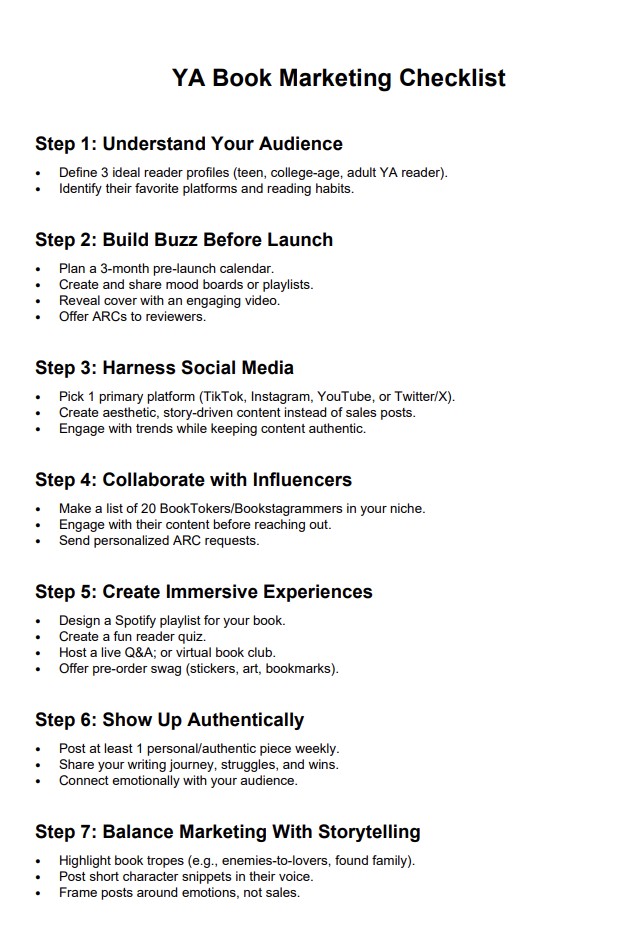How to Effectively Market a Young Adult Book to Your Audience as an Author

Knowing how to effectively market your young adult book to the wide variety of audiences that read the genre is crucial
Publishing your YA novel is a huge achievement — but getting it into the hands of readers is a different challenge entirely.
Young adult books thrive on community, excitement, and emotional connection. Marketing effectively means more than shouting “Buy my book!” — it means creating an experience around your story that invites readers in.
Here’s a detailed roadmap for effectively marketing a YA book.
Step 1: Understand Your Audience
YA isn’t just “teen books.” It’s a wide market that spans several age groups and interests. Before you launch, get clear on who your book is for.
Teens (13–18): Discover books on TikTok, Instagram reels, and through friends. They’re drawn to fast, visual, emotional content.
College-age readers (18–24): Look for deeper discussions about identity, themes, and representation. They like seeing authors engage with book clubs, podcasts, and thoughtful content.
Adult YA readers: Love nostalgia and character-driven stories. Many engage through Instagram, YouTube reviews, or newsletters.
Write down three “ideal reader profiles.” For example:
A 16-year-old who lives on TikTok and loves enemies-to-lovers stories.
A 20-year-old college student who’s active in book clubs and loves stories about mental health.
A 30-year-old mom who reads YA as comfort and follows Bookstagram aesthetics.
Knowing your reader will shape your marketing voice and platforms.
Step 2: Build Buzz Before Your Book Launch
Don’t wait until launch day to start talking about your book. YA readers love anticipation.
Cover reveals: Share your cover through an aesthetic video, not just a static image.
Mood boards & aesthetics: Use Pinterest or Canva to create vibes — dark academia, neon thrillers, fantasy kingdoms.
Early snippets: Post short quotes from your manuscript that spark curiosity.
Create a three-month pre-launch plan. For example:
Month 1: Share mood boards, playlists, and vibes.
Month 2: Reveal your cover and do a “meet the characters” series.
Month 3: Offer ARCs (Advance Review Copies) to bloggers and BookTokers.
Step 3: Harness the Power of Social Media
Social media is where YA books explode. The key? Show, don’t sell.
Instead of: “Buy my book on Amazon!”
Try: “POV: you’re trapped in a zombie escape room and the animatronics don’t look so fake anymore 👀 #YAHorror #BookTok”
What works best on different platforms:
TikTok (BookTok): Short, engaging, emotional clips. Use trending sounds, POV skits, and book aesthetic videos.
Instagram (Bookstagram): Beautiful flatlays, fan art, and reels with storytelling hooks.
YouTube (BookTube): Longer book reviews, vlogs about writing, and “read with me” videos.
Twitter/X: Quick updates, memes, and connecting with fellow authors.
Pick one main platform to focus on. Master it before spreading yourself too thin.
Step 4: Collaborate with Influencers & Reviewers
Word of mouth is powerful in YA. Book bloggers, TikTok creators, and Instagram reviewers have dedicated communities.
Send out ARCs with personalized notes.
Partner on giveaways.
Offer fun collabs (like a “Which character are you?” quiz for their followers).
Make a list of 20 BookTokers/Bookstagrammers who review your genre. Start engaging with their content before asking for reviews.
Step 5: Create Immersive Reader Experiences
YA readers don’t just want to read your book — they want to live it.
Spotify playlists: Curate songs that match your book’s mood.
Quizzes: “Which character are you?” or “What role would you play in this world?”
Virtual book clubs: Host a live Q&A or read-along on Discord, Zoom, or Instagram Live.
Pre-order campaigns: Offer digital art, signed bookmarks, or stickers as rewards.
Choose one fun interactive element (a playlist, a quiz, or pre-order swag) to include in your marketing.
Step 6: Show Up Authentically
YA readers can spot inauthenticity a mile away. They don’t just want your book — they want you.
Share your writing journey — the struggles, the rejections, the moments of joy.
Let your personality shine through in your content.
Talk about why you wrote the story, and who it’s for.
Post at least one “personal” piece of content a week — something that shows your readers the real you behind the book.
Step 7: Balance Marketing With Storytelling
Instead of blasting sales links, weave your marketing into storytelling.
Share snippets that highlight your book’s conflict.
Use tropes as hooks (“enemies-to-lovers, found family, and dark secrets — what more could you want?”).
Let your characters take over a post and “speak” in their own voice.
Create 3 pieces of content this week where you market your book through storytelling instead of selling.
Marketing a YA book is less about chasing trends and more about building community.
If you can create excitement, engage authentically, and invite readers into your world, your book will grow beyond just pages — it will become part of their identity.
Your story deserves to be read. With strategy, creativity, and a touch of vulnerability, you’ll not only reach your audience — you’ll connect with them.

